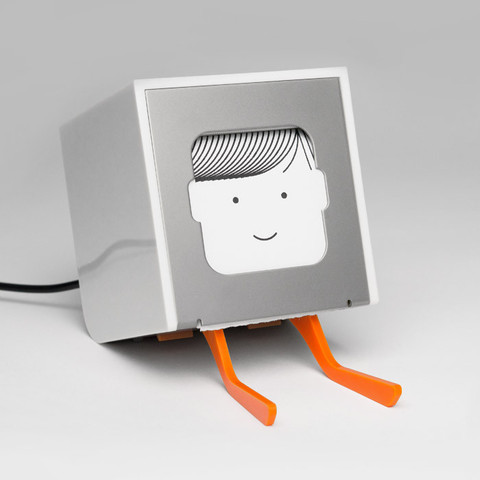
Robohub.org
Robotics trending towards the consumer
Robotics is trending towards the consumer. We’re on a journey towards ‘appliances with attitude’ that started with the now ubiquitous GPS and smartphone technology. These are some of the underlying trends in robotics in the Valley, and elsewhere, that will enable the emergence of single purpose lifestyle consumer robots, like Autom, the robot weightloss coach:
- increase in funding for robotics, both industrial and consumer (eg. Double Robotics, Y Combinator applications, Grishin Robotics, PCH International, Lemnos Labs, Haxlr8tr and the success of consumer electronics on kickstarter generally).
- invisible robots – robotic technologies being incorporated into many devices without our explicit knowledge – we now expect smart devices to respond to our commands – in our vehicles, our homes and our workspaces – we now expect to have a range of interfaces to communicate/control devices.
- smart phones etc – almost everyone carries around a small computer these days.
- increased connectivity – not simply cloud and internet although that’s big too – those pocket computers can be really effective when they can wirelessly connect to devices around us – pocket robot controllers allowing for cheaper, smaller robotic devices.
- increased outsourcing of sensors and intelligence, not just computing power, into our daily lives via the devices around us will allow robots to work for us in more useful ways.
Finally, coming over the horizon is the huge potential for new forms of visible robots (using technology trends like ‘soft bodied robotics’) which do things we haven’t really thought of yet. The democratization of robotics technology means that robotics is no longer the preserve of military and industrial applications.
Robots are becoming more affordable for the long tail of niche applications in the consumer space. That robotics is finally trickling into the consumer space opens Pandora’s box on all the things that robots might be able to do that haven’t had a large enough proven market to warrant investment in the research and development.
Combined with the emerging maker movement, we are entering an age of consumer robotics products and components which can be customized for new use cases on demand. This trend towards ‘bespoke robotics’ is going to catalyze increasingly viable commercial development of robotics components and interfaces.
One end of this is going to be the home vehicle modification space, where aftermarket robotic accessories will enable people to add sensors, collision avoidance mechanisms, auto park etc as aftermarket. This is a highly regulated space, but one in which a huge market is clear.
At the other end of this is the fashion industry, rather than the health industry, which will be comparatively unregulated but incredibly creative and fast moving. Think of FitBitz on steroids. Literally. What if I want my clothing to change color when my mood changes. What if I want my clothing to become armor in a collision/violence situation. What if I want my clothing to send messages to me or my friends when we are proximate. What if I want my clothing to act as an exercise machine and provide resistance. Or the opposite, can I engage additional strength to help me lift objects, my shopping bags etc.
Having rhapsodized about a future that is still someways off, I’d like to close by saying that for me the robot achievement of 2012 isn’t Baxter from Rethink Robotics. It’s Autom, the robot weightloss coach now on sale, by Cory Kidd and Intuitive Automata.
2010 marked the emergence of crowdfunding for internet of things and consumer devices. 2011 was the year of smartphone robots. 2012 has seen the consolidation these trends into funded startups with strong retail markets (eg Orbotix, Romotive) and the emergence of a new genre of consumer robot – the lifestyle robot.
As a consumer, I’m absolutely willing to buy a robot (or smart device) that helps me achieve lifestyle goals, as long as it’s affordable (<$500), easy to interface with (voice/touch/smartphone) and does one thing well.
We’d all love to have a general purpose household robot but Rosie Jetson just isn’t ready yet. I’m happy to have several small affordable robots that do just one thing well. One to vacuum, one to fold clothes, one to help me lose weight.
You could say that these are just appliances, and that would be correct. But the research behind Autom confirms that people like to interact with embodied devices that can engage in a social relationship with us. I see the future of robotics as ‘appliances with attitude’.
tags: analysis, Andra Keay, Autom, consumer robot

Andra Keay
is the Managing Director of Silicon Valley Robotics, founder of Women in Robotics and is a mentor, investor and advisor to startups, accelerators and think tanks, with a strong interest in commercializing socially positive robotics and AI.

Andra Keay
is the Managing Director of Silicon Valley Robotics, founder of Women in Robotics and is a mentor, investor and advisor to startups, accelerators and think tanks, with a strong interest in commercializing socially positive robotics and AI.
Related posts :
Robot Talk Episode 136 – Making driverless vehicles smarter, with Shimon Whiteson
Robot Talk
05 Dec 2025
In the latest episode of the Robot Talk podcast, Claire chatted to Shimon Whiteson from Waymo about machine learning for autonomous vehicles.
Teaching robot policies without new demonstrations: interview with Jiahui Zhang and Jesse Zhang
Lucy Smith
04 Dec 2025
Hear from authors of work presented at CoRL 2025.
Why companies don’t share AV crash data – and how they could
Cornell University
01 Dec 2025
Researchers have created a roadmap outlining the barriers and opportunities to encourage AV companies to share the data to make AVs safer.
Robot Talk Episode 135 – Robot anatomy and design, with Chapa Sirithunge
Robot Talk
28 Nov 2025
In the latest episode of the Robot Talk podcast, Claire chatted to Chapa Sirithunge from University of Cambridge about what robots can teach us about human anatomy, and vice versa.
Learning robust controllers that work across many partially observable environments
Maris Galesloot
27 Nov 2025
Exploring designing controllers that perform reliably even when the environment may not be precisely known.
Human-robot interaction design retreat
Lucy Smith
25 Nov 2025
Find out more about an event exploring design for human-robot interaction.
Robot Talk Episode 134 – Robotics as a hobby, with Kevin McAleer
Robot Talk
21 Nov 2025
In the latest episode of the Robot Talk podcast, Claire chatted to Kevin McAleer from kevsrobots about how to get started building robots at home.
ACM SIGAI Autonomous Agents Award 2026 open for nominations
ACM SIGAI
19 Nov 2025
Nominations are solicited for the 2026 ACM SIGAI Autonomous Agents Research Award.



